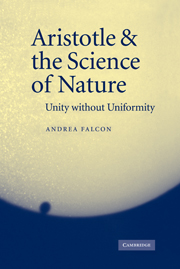1 - The unity, structure, and boundaries of Aristotle's science of nature
Published online by Cambridge University Press: 22 September 2009
Summary
INTRODUCTION
Asked to what end one should choose to live, Anaxagoras replied “to study the heaven and the order of the whole cosmos”
(Aristotle, EE 1216 a 12–14 = DK 59 a 30).Aristotle is not merely concerned with solving a list of problems or discussing a certain number of topics. He is engaged in an ambitious project of investigation. This project consists in an attempt to establish the right sort of connections – explanatory connections – between the things of the world. If this investigation is successful, it not only provides us with knowledge, but it gives us understanding of the world. The investigation of the natural world is no exception to this rule. Aristotle has left a certain number of logoi, each of which is a relatively independent and sufficiently self-contained argument devoted to a particular topic or problem. But there is no doubt that these logoi are conceived as parts of a unitary project of investigation. There is also no doubt that Aristotle has a certain understanding of the relations between these parts. This understanding is strongly dependent upon a specific conception of the natural world and the substantial assumption that this particular department of reality is, at least to some extent, intelligible to us. More directly, Aristotle is persuaded that the natural condition for human beings is to know and understand the truth, and that we can know and understand a lot about the natural world if only our investigation is conducted in the appropriate way.
- Type
- Chapter
- Information
- Aristotle and the Science of NatureUnity without Uniformity, pp. 1 - 30Publisher: Cambridge University PressPrint publication year: 2005



